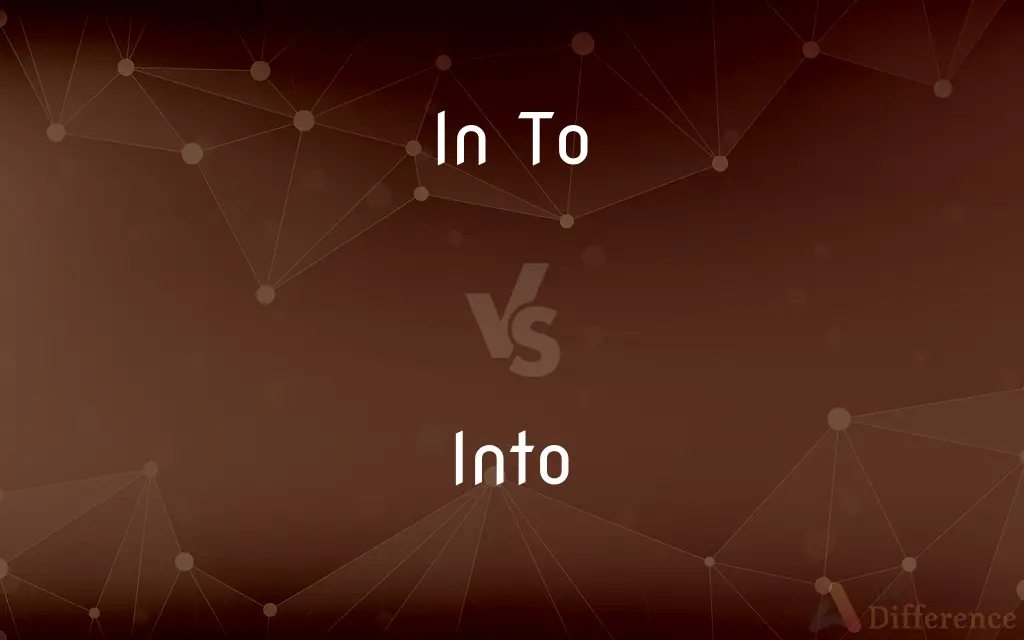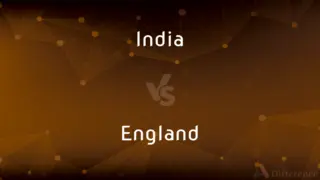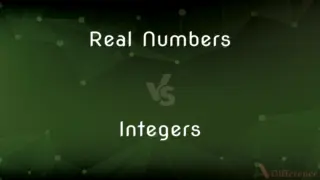In To vs. Into — What's the Difference?
By Tayyaba Rehman — Published on October 14, 2023
"In To" is two separate words implying separate actions, while "Into" is a preposition showing movement or transformation.

Difference Between In To and Into
Table of Contents
ADVERTISEMENT
Key Differences
"In To" is often used when "in" is part of a verb phrase, and "to" begins a prepositional or infinitive phrase. On the other hand, "Into" indicates direction, motion, or a state of transformation. For example, you could "turn in" a paper "to" your professor, but you could dive "into" a pool.
Usage of "In To" and "Into" can be context-specific. "In To" might appear when "in" concludes a verb and is followed by another phrase starting with "to". Contrastingly, "Into" typically indicates movement, like going inside something.
A helpful way to discern the two is by attempting to separate "in" and "to". If the sentence still makes sense with them apart, "In To" is correct. If the meaning changes, "Into" is likely the right choice.
Understanding the difference is vital for accurate communication. Using "In To" instead of "Into" or vice versa can alter the message you're trying to convey, making it crucial to select the appropriate term for your intended meaning.
Comparison Chart
Grammatical Role
Two separate words indicating distinct actions.
A preposition indicating motion or transformation.
ADVERTISEMENT
Usage
Used when "in" concludes a verb and is followed by "to".
Indicates movement, like going inside something.
Meaning
"In" is often part of a verb phrase; "to" starts a subsequent phrase.
Indicates direction or transition from one state to another.
Sentence Interpretation
If "in" and "to" can stand separately without changing meaning, it's "In To".
If separating changes the sentence's meaning, it's "Into".
Example
"He turned his homework in to the teacher."
"She walked into the room."
Compare with Definitions
In To
"In" is an adverb; "to" prepositions the next part.
He came in to discuss the project.
Into
Indicates transformation or change in state.
Water turns into ice when frozen.
In To
"In" indicates a position; "to" introduces a purpose.
He was in to visit his grandmother.
Into
Preposition showing direction or movement.
She went into the store.
In To
"In" is a part of a verb phrase; "to" begins the next phrase.
I turned the assignment in to my instructor.
Into
Suggests involvement or interest.
He's really into jazz music.
In To
"In" completes the action of a verb; "to" starts another phrase.
He logged in to access his email.
Into
Refers to divisions or segments.
Cut the pie into eight pieces.
In To
"In" denotes a state; "to" introduces direction.
They broke the door in to save the trapped cat.
Into
Denotes a point in time.
The party went on into the night.
Into
To the inside or interior of
Went into the house.
Into
To the activity or occupation of
Recent college graduates who go into banking.
Into
To the condition, state, or form of
Dishes breaking into pieces.
Changed into a butterfly.
Into
So as to be in or be included in
Parties entering into an agreement.
Wrote a new character into the play.
Into
(Informal) Interested in or involved with
They are into vegetarianism.
Into
To a point within the limits of a period of time or extent of space
Well into the week.
Into
In the direction of; toward
Looked into the distance.
Pointed into the sky.
Into
Against
Crashed into a tree.
Into
As a divisor of
The number 3 goes into 9 three times.
Into
To or towards the inside of.
Mary danced into the house.
Pour the wine into the decanter.
The nomads shave intricate designs into their camels' fur.
Into
To or towards the region of.
We left the house and walked into the street.
The eagle flew off into the wide blue sky.
Into
Against, especially with force or violence.
The car crashed into the tree.
I wasn't careful, and walked into a wall.
Into
Indicates transition into another form or substance.
I carved the piece of driftwood into a sculpture of a whale.
Right before our eyes, Jake turned into a wolf!
Into
Indicates division or the creation of subgroups or sections.
A cow's stomach is divided into four chambers.
Into
After the start of.
About 20 minutes into the flight, the pilot reported a fire on board.
Into
(colloquial) Interested in or attracted to.
She's really into Shakespeare right now.
My date for tonight has black hair, and I'm into that.
Into
Expressing the operation of multiplication.
Five into three is fifteen.
Into
(mathematics) Expressing the operation of division, with the denominator given first. Usually with "goes".
Three into two won't go.
24 goes into 48 how many times?
Into
Investigating the subject (of).
There have been calls for research into the pesticides that are blamed for the decline in bee populations.
Into
To the inside of; within. It is used in a variety of applications.
Into
Expressing entrance, or a passing from the outside of a thing to its interior parts; - following verbs expressing motion; as, come into the house; go into the church; one stream falls or runs into another; water enters into the fine vessels of plants.
Into
Expressing penetration beyond the outside or surface, or access to the inside, or contents; as, to look into a letter or book; to look into an apartment.
Into
Indicating insertion; as, to infuse more spirit or animation into a composition.
Into
Denoting inclusion; as, put these ideas into other words.
Into
Indicating the passing of a thing from one form, condition, or state to another; as, compound substances may be resolved into others which are more simple; ice is convertible into water, and water into vapor; men are more easily drawn than forced into compliance; we may reduce many distinct substances into one mass; men are led by evidence into belief of truth, and are often enticed into the commission of crimes; she burst into tears; children are sometimes frightened into fits; all persons are liable to be seduced into error and folly.
Common Curiosities
What does "Into" often indicate?
"Into" typically indicates motion, transformation, or direction.
Can "In To" and "Into" be used interchangeably?
No, they have distinct grammatical roles and meanings.
Is "Into" a single word?
Yes, "Into" is a single preposition.
Give an example of "In To" in a sentence.
"She checked in to her flight online."
Can I separate "Into" into two words in a sentence?
No, if "Into" is the correct term, separating it will change the sentence's meaning.
Give an example of "Into" in a sentence.
"She walked into the room."
Can "In To" be seen in phrases like "tune in to"?
Yes, "tune in" is a verb phrase, and "to" starts the next phrase, as in "tune in to the radio".
When should I use "In To"?
Use "In To" when "in" ends a verb phrase and is followed by a phrase starting with "to".
Is "Into" always about physical movement?
No, it can also indicate transformation or interest, like "turning into" or "being into" something.
What's a quick tip to discern "In To" from "Into"?
If "in" and "to" can stand separately without changing meaning, it's "In To". If not, it's "Into".
Share Your Discovery

Previous Comparison
India vs. England
Next Comparison
Real Numbers vs. IntegersAuthor Spotlight
Written by
Tayyaba RehmanTayyaba Rehman is a distinguished writer, currently serving as a primary contributor to askdifference.com. As a researcher in semantics and etymology, Tayyaba's passion for the complexity of languages and their distinctions has found a perfect home on the platform. Tayyaba delves into the intricacies of language, distinguishing between commonly confused words and phrases, thereby providing clarity for readers worldwide.
















































